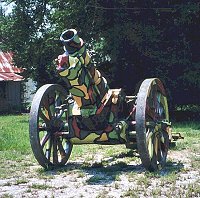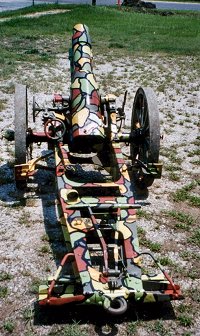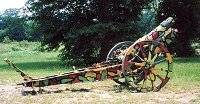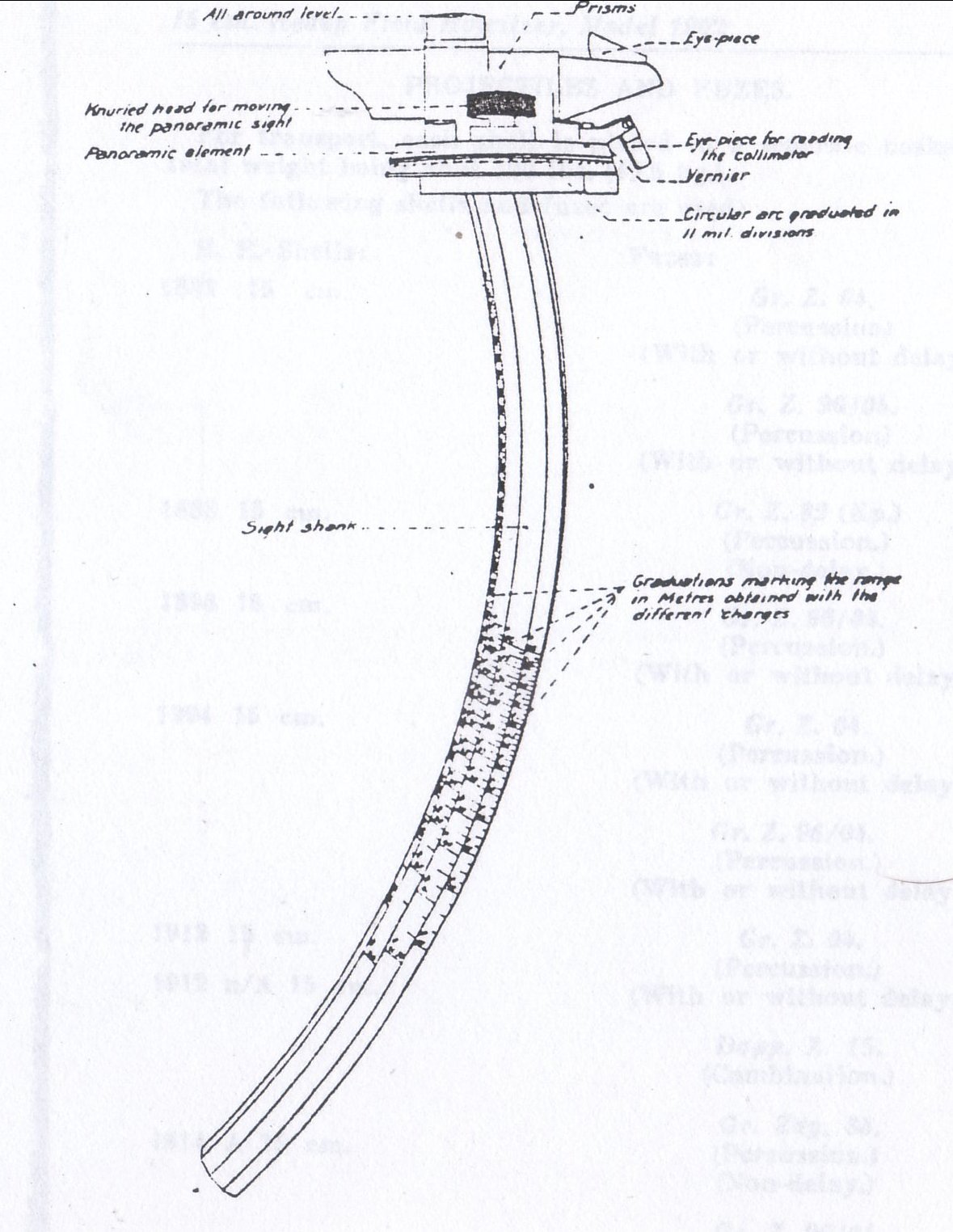
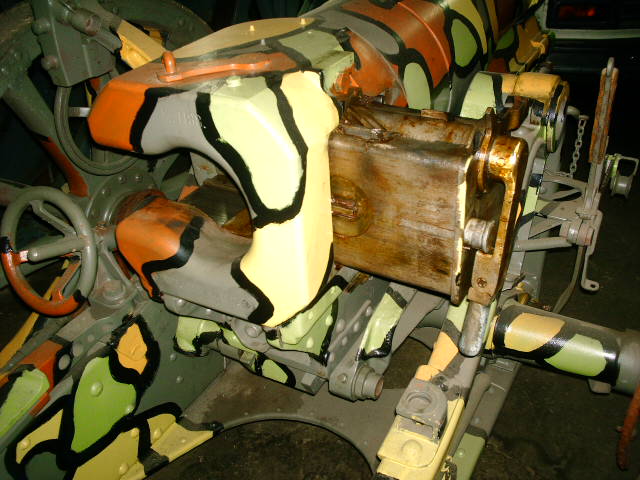
This is the second example of a 15cm. s.F.H. 1902 in the Lovett collection. This one is dated 1917. It lacks the ornamental “William Rex II and Crown” barrel scroll of the older 1909 dated piece. It was common for a wartime manufactured piece to have fewer “nice to have items”. The direct fire iron sight is also abbreviated. The camouflage is a typical German wartime disruptive scheme. This disruptive or “tortoise shell” style camouflage is also frequently seen on German WW1 steel helmets. The Cubist Art movement popular in pre-war Europe directly influenced this style.
 |
Development of the 15cm. s.F.H. 1902
(by Ralph Lovett)
The s.F.H. 1902 has a reliable hydro-spring recoil mechanism. Its design incorporates the use of a percussion firing mechanism. It has a longer, more manageable carriage. As one might expect the development between the s.F.H. of 1893, and the s.F.H. 1902 was not direct. There was a V.H. 99 howitzer, which never went into general production, that smoothed the way experimentally dealing with the problems of recoil and the percussion firing mechanism.
During the late 1890’s both France and Germany introduced artillery with effective recoil systems such as, the French Schnieder 75mm Mle 1897, the Rimailho 155mm howitzer and the German Krupp l.F.K. 7.7cm 1896 n/a. In 1897 the APK contacted the Krupp company to develop a howitzer with a recoil system. A number of types were under development to meet this request. With this development in progress, and the fact that the General Inspectorate of Foot Artillery wanted the replacement of the older fortress guns (the 15cm 1882 mortar and the long 15cm mortar 1892) with longer range pieces, it seems the climate was favorable to further develop a recoil-howitzer9. Further, this howitzer could serve both a field and fortress role. Technical details such as deletion of the 45 degree elevation requirement and setting a requirement for range of 7000 meters was worked out between the War Ministry and the General Inspectorate of Foot Artillery.10
By the fall of 1899 a request was made from Krupp for a field mobile 15cm. howitzer to be transported at a walking or trotting pace with crew mounted. I n August 1900 Krupp delivered the V.H. 1899(Experimental Howitzer 1899). This weapon was tested roughly one year and in 1901 the War Ministry placed an order for 24 V.H. 99’s with Krupp.11 The V.H. 99 was fired in field trials to compare its performance with the s.F.H. of 1893. Although the V.H. 99 met the agreed requirements it was rejected from service with the Foot Artillery. It was found to be unwieldy and awkward in a firing position. Because of its short recoil, 340mm, and its weight (tube 990 kg. and carriage 1345 kg.) its wheels sank deep into the ground. Based on test reports from the 4th Battery of the Dieskau Regiment demands were made to redesign the howitzer, to making it lighter, to give it a longer carriage and provide it with a traversing mechanism within the upper carriage. These suggestions led to the “lighted howitzer” which was subsequently approved for service and designated the s.F.H. 1902 on 18 June 1903. Afterward it was gradually issued to field and fortress batteries. Many of the performance characteristics of the V.H. 99 are present in the s.F.H. 1902 including its maximum range of 7450 meters. However, the weight of the breech was reduced by 186 kg. and the carriage weight by 155 kg. from that of the V.H. The length of recoil was increased from 340 mm. to approximately 650 mm.12 The s.F.H. “02 was also provided with a traversing mechanism which allows 4 degrees of movement. The elevating mechanism will allow movement from 0 to 42 degrees.13 The “02 is sighted by a dial/optical indirect fire sight. Some pre-war pieces also have a crude metal direct fire sight. Wartime production “02’s do not have this sight or the pre-war ornamental scroll work. The trail is considerably longer than the s.F.H. of 1893 and the V.H. 99. Consequently one man can pick up the howitzer at the lunette. This is not possible with the s.F.H. “93 and is in fact difficult with two men even using levers. The wire-rope and brake pad system for the “02 was generally the same as that on the “93. This allows the brakes to be applied when traveling, using cords pulled by crewmen ridding on the limber, or before firing simply by hand. The effectiveness of this new howitzer was also improved by the introduction of the 15cm. 04 shell, which has a shell weight of 40.5 kg. and a delayed-action fuze for penetrating covered entrenchments.14 Improvements in optics, (forward observer scope), communications (field-phones), and magnetic dial-type aiming circle with an optical scope improved the efficiency and accuracy of the Foot Artillery in field service. It is important also to note that all of these improvements were retrofitted to the older s.F.H. “93 which continued in service in large numbers.
Participation in tactical maneuvers as well as live fire exercises utilizing forward observers greatly enhanced the effectiveness of this new arm. Almost as important this efficiency was gaining the acceptance and respect of the maneuver forces. 8 August 1906 Kaiser William II addressed his officers following a live fire exercise at Wahn. In part saying “There is no doubt that the infantry and the field artillery, that are confronted with such targets as they have engaged today, will breathe a sigh of relief when their heavy shells hit the enemy lines, and that the spirit of advance and a grateful feeling towards heavy artillery will pervade them.” Dedication for maintaining and increasing performance standards could be seen in annul “Kaiser’s Shooting Completions”. To meet the standard, s.F.H. “02 batteries would take 17 to 18 minutes to emplace and lay their howitzers and would then fire 100 shots at two targets. One target would represent an enemy battery 5000 meters distant and the second an entrenched infantry position 4500 meters distant. The battery undergoing evaluation would not receive their “call for fire” until the howitzers were unlimbered.15
In France the s.F.H. 1902’s counterpart was developed. It had 6000 meters range with 3200 kg. weight in firing position, 1164 kg. heavier than the “02. Despite being marginally less mobile the French Rimailho howitzer was a good match for the “02.
It is astounding to note that in the face of this development France chose to reject heavy-recoil howitzers for field service. Showing the influence and mindset of the maneuver commanders. With the exception of the 65mm Schneider-Ducrest Model 1906 mountain howitzer and the Colonial Service mountain howitzer 70mm S.A. St.- Chamond the French also rejected light field howitzers from service. Strangely, the advantages of the howitzer were seen in mountainous terrain but not in what was expected for the regular field army. What part of Western Europe does not have hills and defilades? What infantryman does not have an entrenching tool? It was felt that all fire support needs could be met by the flat trajectory of the 75m Mle 1897 field gun. This error was one of many that cost France much in lives and real estate. In 1914 all of Belgium and much of France was lost, 955,000 French troops quickly fell or were captured, with nearly two million in 1915. France was clearly beaten back by a far superior enemy. Much has been made of the obvious differences in their infantry tactics, but one of the main material and technological differences in the two forces lay with their artillery. It seems probable that the French themselves recognized their error following the tremendous losses of 1914. They spent the remainder of the war trying to match the German heavy howitzer technology and tactics.
(See the "Develpment of the German 15cm" page for more information and the foot notes)
15cm. s.F.H. Cammo Image Gallery
(click on the thumbnail for larger image)
